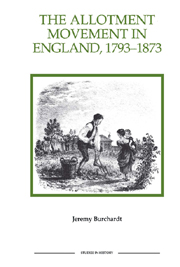Book contents
- Frontmatter
- Contents
- List of tables
- Acknowledgements
- Abbreviations
- Introduction
- PART I THE FIRST ALLOTMENT MOVEMENT
- PART II THE SECOND ALLOTMENT MOVEMENT
- PART III ALLOTMENTS AND RURAL SOCIETY
- PART IV TOWARDS THE THIRD ALLOTMENT MOVEMENT
- Conclusion
- 1 The allotments database
- 2 The origins and definition of allotments
- 3 Allotments and potato grounds
- 4 Legislative limits on plot size
- 5 Allotment plot size
- 6 Allotment rent
- 7 Animal-keeping on allotments
- 8 Allotment site rules
- Bibliography
- Index
1 - The allotments database
Published online by Cambridge University Press: 12 September 2012
- Frontmatter
- Contents
- List of tables
- Acknowledgements
- Abbreviations
- Introduction
- PART I THE FIRST ALLOTMENT MOVEMENT
- PART II THE SECOND ALLOTMENT MOVEMENT
- PART III ALLOTMENTS AND RURAL SOCIETY
- PART IV TOWARDS THE THIRD ALLOTMENT MOVEMENT
- Conclusion
- 1 The allotments database
- 2 The origins and definition of allotments
- 3 Allotments and potato grounds
- 4 Legislative limits on plot size
- 5 Allotment plot size
- 6 Allotment rent
- 7 Animal-keeping on allotments
- 8 Allotment site rules
- Bibliography
- Index
Summary
Much of the statistical evidence used in this book derives from the allotments database, a dataset compiled by the author for this purpose. The database consists of 1,971 records from 1,641 different allotment sites between the years 1795 and 1873. Each record is for a particular site in a particular year. As many primary sources as possible containing information about allotments in the relevant period were located and all information contained in them about specifically-named allotment sites noted on filing cards. It was then necessary to establish criteria for inclusion in the computer database. The first criterion was that the record should genuinely be for an allotment site, rather than some other form of landholding. In particular, it was important to exclude all records which were actually for potato grounds. Potato grounds differed in many important respects from allotments, but especially in the early years of the nineteenth century were not always sharply differentiated from them by contemporaries (see chapters 1 and 2 and appendix 2). In constructing the database, it was usually easy to identify potato grounds because they were let, on a temporary basis, by farmers to their own labourers rather than by landowners to the inhabitants of the parish in general. Doubtful cases (including many from the 1834 poor law commissioners' ‘Rural queries’) were excluded from the database. The second criterion for inclusion was that the record must be unique, in that it did not duplicate any other record in the database.
- Type
- Chapter
- Information
- The Allotment Movement in England, 1793–1873 , pp. 237 - 239Publisher: Boydell & BrewerPrint publication year: 2002



